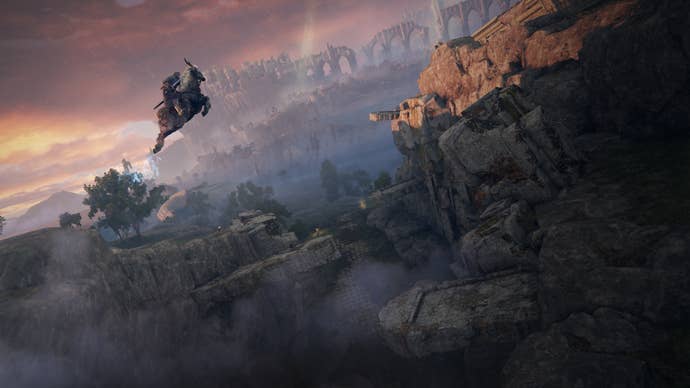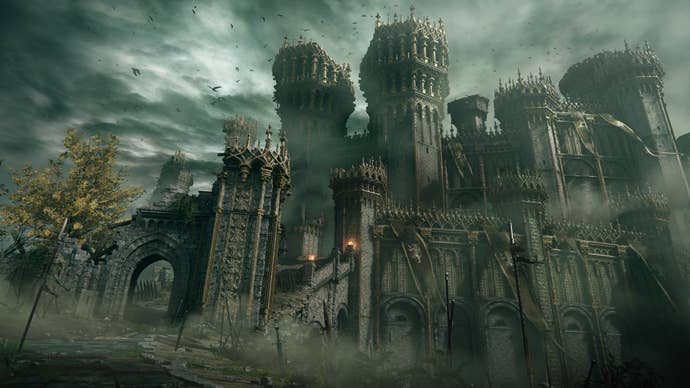Elden Ring review - Lording it over everything else
Elden Ring has been worth the wait.
Elden Ring is an open world game, but perhaps not in the way you might think when you first hear those words.
It's not about waypoints pointing you off to a distant location, or following a map that over-populates with activity icons. Instead, it's about pure, unbridled exploration. Think about the hands-off, player-trusting approach previous Souls games took to things like character progression and storytelling. Apply that philosophy to an open-ended land, and you get the backbone of a game that is, ultimately, a bit of a masterpiece.
The game is named Elden Ring after an all-powerful plot MacGuffin, but I came to think of it as Endless Ring. The early game is relentless in handing you a series of key tools in quick succession – most importantly your horse – but then it sets you free. Venture in any random direction you want. Something catch your eye? Try to make your way there. Do what you want. Elden Ring doesn't care.
The result feels vaguely ridiculous. Over 60 hours into the game, I was still discovering entire hidden areas, caves tucked away into the side of mountains, walking mausoleums, crumbled shacks with a wayward NPC or an intriguing tale to be uncovered. Much of this is accessible from the beginning – only a scant few areas are locked behind bosses or other progression gates. And even when something is kept gated from you, it feels mind-bogglingly expansive rather than cheap; when defeating a boss causes a world state change that opens up vast new areas it's amazing enough – but when it happens 50+ hours in, and to an area you thought you'd exhausted, it's difficult to not say ‘wow’.
Elden Ring is not just adept at consistently creating this sense of mystery as you simply gallop through its world, it’s also ready to reward you for going after those pursuits. You’ll come away with crafting and upgrade materials, new weapons and armour – and you might even meet unique characters and fight bosses you won’t otherwise see on the main path.
And what main path? Well, there is one – but it is, by design, pretty obscure. Without getting into spoilers, here's how it works: there are several Lords out in the world, hiding away inside 'Legacy Dungeons', more traditional Souls levels where your horse isn't available. You'll need to beat at least two of these Lords in order to progress to a key story location – but in terms of the first half of the game, that is the sum total of what you must do.
The areas you explore, route you take, and enemies you face down along the way will differ depending on your approach – and FromSoftware appears to have built the game with divergent routes and deliberate sequence breaks in mind. Basically, speed-running strats and optimisation for this game are going to be delicious. The back third of the game feels a little more directed and features more mandatory bosses, but the world is still resolutely open.

From’s other major pillar is combat. Elden Ring brings back the tried-and-true stamina-based combat we’re used to from Soulsborne games, and even finds room to incorporate a thing or two from Sekiro. Encounters are often challenging, particularly early on, and the variety of enemies you fight spur you to change your play style so you’re not locked into the standard sword-and-board or i-frame dodge spam (which is when you avoid hits by rolling into them).
This fluidity wasn’t always easy to come to terms with, as I tend to play these games one way for the entirety of a playthrough – only changing my style when absolutely necessary. I was not prepared to have to juggle a couple of different weapons, outfits, and even my approach to certain situations over the course of the game. That has always been true for bosses, of course, but you’ll be dealing with this shift in design as you traverse Elden Ring’s overworld. It’s a tweak to that tried-and-tested formula that makes the whole experience even more compelling.
To facilitate the need for a variety of playstyles, Elden Ring makes it easy to equip and keep ranged options on hand. That may be a standard bow or crossbow, or a staff for some fire-and-forget magic spells. You’re encouraged to diversify beyond what you might be used to from past games; well-rounded characters will have an easier time in this world, whereas specialists might die (more).
Traditional series elements have been tweaked to tie combat and exploration together. One constant concern in other Souls games was how finite healing items are, for instance. This is still true in Elden Ring, but out in the overworld, defeating groups of enemies or certain rare critters offers refills to your HP or FP flasks. This might sound like it goes against the signature difficulty of these games, but it is simply an open-world conceit – there's no such respite within dungeons. By giving you a way to refill your healing resource, Elden Ring is essentially refueling your sense of discovery.
Checkpoints also serve to help ease exploration. If you bump into a huge boss in the open world, it’ll inevitably be close to a Stake of Marika, and when you die you’ll be given the option of spawning at a Site of Grace (that’s a bonfire, basically) or at the Stake as a checkpoint. Plus there’s your horse, which is fast enough that you can summon it, retrieve the Runes (that’s Souls) lost on death and disappear before enemies are any the wiser.
Combat is another element that will also benefit from your hunger for exploration. Your repertoire of moves will increase as you expand your Ash of War library, not to mention your stock of weapons and upgrade materials themselves. Ashes of War are essentially Weapon Arts from Dark Souls 3, refined to be actually viable rather than just a novelty.
Each Ash of War ties a certain move or skill to a weapon, available when two-handing it. They consume varying amounts of FP, but it’s usually low enough that even a warrior-type character with low investment in Mind (the FP stat) can still regularly rely on them for that quick flash of fancy finesse where necessary.

This marriage of exploration and combat informs Elden Ring's rare cohesion in design. The deeper you look, the more of these multi-faceted elements will reveal themselves. Your steed, Torrent, is obviously necessary to quickly travel vast distances in the overworld, but its combat benefits are less clear.
You can fight on horseback, and you’ll come across many enemy units doing the same. Horseback combat is sadly a little clumsy, though. Even though you can control which side of the horse your weapon swings, I found that hits have a tendency to whiff (including when you’re locked on to enemies). It’s not always clear whether this is a height or a distance problem, but you’ll be left hoping your weapon was just a tad longer fairly often.
Nevertheless, having the ability to take on enemies from horseback creates several new gameplay opportunities. I found it particularly useful to pick off a few stragglers before dismounting to hit the main camp. The speed of the horse also comes in handy when rushing to eliminate the units that can call reinforcements, before dealing with the rest of the squad. It can even be amusing to perform a few hit-and-runs on some helpless infantry as you run circles around them while they struggle to track you.
Torrent’s real combat role becomes almost a necessity when taking on field bosses, which is something new in Elden Ring. As you explore the world, you’ll find these towering knights, monsters, dragons – or inexplicable creatures that you would typically be locked in an arena with – simply patrolling an area.
Once you start the fight, the health bar shows up, and the music kicks in – except, of course, the 'arena' is essentially anywhere you like. Bosses will not follow you everywhere, however, and will attempt to go back to their intended area when you try to trick them into cheese spots. Having a horse makes the experience of fighting those bosses unique from the enclosed arena fights you’re used to. Many of their attacks are also wide and far-reaching enough to nudge you into staying on your horse to easily outrun them.
All of the horse's movement abilities, such as the double-jump, are unlocked from the off. That said, I do wish Torrent had a few more combat abilities beyond just being a mount.

In order to sustain your long journeys, Elden Ring introduces a crafting system. This ends up being one of the game’s weakest elements, ironically because it’s more fleshed out than I would have liked. There are some 40-something crafting materials you’ll find across the game’s world. Everything from animal and bird parts, to fungi, flora, and bugs – you name it. Rather than be informed by the same mantra of exploration and discovery, crafting in Elden Ring is an arbitrary, game-y process.
You might have everything you need to craft an item, but you won’t be able to until you find the specific cookbook – and there are plenty of those – which unlocks the ability to do it. The sheer number and distribution of crafting materials also makes it unlikely that you’ll organically have everything you need, whenever you feel like you need it.
More often than not, you’ll be checking the menu to craft something, only to find that you’re missing one or more components. I don’t imagine anyone is going to stop what they’re doing in that instance and try and look for the missing ingredient. This level of depth is more suited to survival games, where it’s common to regularly consult a compendium of crafting materials and their locations as you play. In a FromSoft game, it feels almost shoe-horned in; an element gleaned from Breath of the Wild that could have happily stayed in Hyrule.
When crafting was revealed ahead of Elden Ring’s launch, I thought it would be a lot more scrappy; the type of system that quickly lets you turn twigs into arrows behind cover before reemerging to continue the fight. But the crafting system we ended up with actually gets locked as soon as you enter combat, and though the options it offers are vast, it also relies on a needlessly long list of ingredients.
I’ve only really used it to craft arrows, throwing darts, and the occasional boosts. Typically, I would check if I can craft something, and end up just buying it because some ingredients are missing. Not exactly the revolutionary system you might have been hoping for.
.jpg?width=690&quality=70&format=jpg&auto=webp)
Perhaps the most disappointing aspect about Elden Ring is its general difficulty. This might seem like a strange point to bring up, considering the subject, but it often felt like encounters are designed with co-op, or the new AI summon mechanic in mind. As in earlier From games, you can touch the summon signs of NPCs and other human players to aid you along the way.
But while those are typically meant for boss fights, there’s another system that will help you deal with the difficulty of normal encounters. As you explore Elden Ring’s world, complete quests and so on, you’ll accumulate spirits of fallen warriors. These come in the form of a single, powerful unit, or a group of them. The first one you acquire lets you call on wolves, for example.
You use FP to summon your allies, and you can only do so in areas with a Rebirth Monument. The game shows an icon on your HUD to let you know it’s possible to summon. The FP cost varies from one spirit to the next, and you can only summon one group per Rebirth Monument.
I initially suspected that this mechanic was meant to aid players new to FromSoftware’s games. Elden Ring is poised to be the studio’s biggest hit, so it’s understandable that the team wanted a soft difficulty modifier so as not to crush those of us not used to how grueling these games can be. But the more I played, the more it became clear that the game expects you to summon your spirit friends. And often.
A lot of the open-world encounters in the mid and late-game will pit you against large groups containing multiple heavy-hitting, tanky units. You can certainly spend a few minutes peeling individual units off one by one, but this can get tiresome after 30 hours or so. Spirit summons can help keep enemies occupied as you either slip past them, or keep them distracted enough that you can deal damage with little risk.
I've also found that bosses expect you to summon here and there. Even with power-appropriate weapons, bosses in Elden Ring have shockingly large HP. Part of that is the fact that the same bar now includes both phases, but it’s still larger than I’ve come to expect. Boss design has evolved significantly since the days you could run circles around them. Many of them are ferocious, and will consistently track you, even mid-combo.
They also have a tendency to chase after you the minute you pull away to heal up. All of this made it more difficult for me to take them on solo, as I always do. To From’s credit, boss super armour is more pronounced now than it’s ever been. Even though that status is never exposed, you can gradually chip away at super armour by landing overhead and charged heavy attacks.
If you keep on the offensive, even if just throwing feeble bone darts at them to prevent it from rebounding, you’re more likely to stagger them and hear the big boom letting you know you can get in for a critical hit.
That said, this isn't a game I was able to single-character from start to finish, which is something I look forward to from the studio’s work. Though my issues with crafting can mostly be alleviated by simply ignoring the system altogether, difficulty and its direct relation to summons is a problem that didn’t need to exist.
I played Elden Ring on a powerful PC with an i7 9700K and a 3080 Ti. The game can’t go over 60fps, like other From games. It ran about as well as I expected at 4K with everything maxed out, with the occasional drops in effects-heavy scenes. However, the game’s biggest performance hiccup is stuttering: they’re most certainly related to asset streaming because they tend to occur in the open world when you quickly turn one direction the game wasn’t expecting you to. Even on a Gen 3 NVMe SSD, these stutters could be clearly felt – and sometimes lasted for several seconds. It’s hard to say whether this will be improved, but as it currently stands, it’s going to get you killed now and then.
None of my complaints were enough to sour my time with Elden Ring, though. I have been playing it almost non-stop for a week, and I’ve wanted to jump back in every chance I got – even at the height of my frustration with it. Elden Ring is a sublime action game with exceptional level design that does a great service to both its classic Legacy Dungeon expectations, and its open world ambitions.
Beyond that, it continues to prove that FromSoftware understands what makes its work special. I went in expecting Elden Ring to be a good game, but I wasn’t quite ready for (almost) all of its individual components to be this well in-sync. FromSoftware is clearly a studio capable of sensible innovation, iterating only on the best parts of its lineage, and that can be keenly felt in Elden Ring.
Whenever a game gets a perfect review score, it brings up the argument of whether it’s really a perfect game, or if a perfect game even exists. The interpretation of what’s deserving that score likely varies from one player to another, but I don’t believe it denotes a game devoid of issues. As this review details, Elden Ring is not without its missteps.
What ultimately matters, however, is that Elden Ring succeeds at almost every goal it sets out to achieve. It’s the culmination of years of refinement of FromSoftware’s formula. Mechanically, and thematically, this is a game making a statement: that you can buck industry tendencies even as you adopt their trends.
Version tested: PC. Code provided by publisher.







.jpg?width=291&height=164&fit=crop&quality=80&format=jpg&auto=webp)


